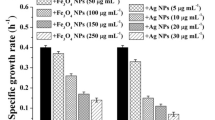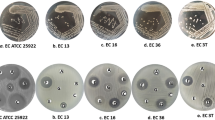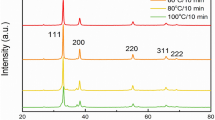Abstract
The antibacterial activity and acting mechanism of silver nanoparticles (SNPs) on Escherichia coli ATCC 8739 were investigated in this study by analyzing the growth, permeability, and morphology of the bacterial cells following treatment with SNPs. The experimental results indicated 10 μg/ml SNPs could completely inhibit the growth of 107 cfu/ml E. coli cells in liquid Mueller–Hinton medium. Meanwhile, SNPs resulted in the leakage of reducing sugars and proteins and induced the respiratory chain dehydrogenases into inactive state, suggesting that SNPs were able to destroy the permeability of the bacterial membranes. When the cells of E. coli were exposed to 50 μg/ml SNPs, many pits and gaps were observed in bacterial cells by transmission electron microscopy and scanning electron microscopy, and the cell membrane was fragmentary, indicating the bacterial cells were damaged severely. After being exposed to 10 μg/ml SNPs, the membrane vesicles were dissolved and dispersed, and their membrane components became disorganized and scattered from their original ordered and close arrangement based on TEM observation. In conclusion, the combined results suggested that SNPs may damage the structure of bacterial cell membrane and depress the activity of some membranous enzymes, which cause E. coli bacteria to die eventually.






Similar content being viewed by others
References
Ahearn DG, May LL, Gabriel MM (1995) Adherence of organisms to silver-coated surfaces. J Ind Microbiol 15:372–376
Alt V, Bechert T, Steinrucke P, Wagener M, Seidel P, Dingeldein E, Domann E, Schnettler R (2004) An in vitro assessment of the antibacterial properties and cytotoxicity of nanoparticulate silver bone cement. Biomaterials 25:4383–4391
Amro NA, Kotra LP, Wadu-Mesthrige K, Bulychev A, Mobashery S, Liu G (2000) High-resolution atomic force microscopy studies of the Escherichia coli outer membrane: structural basis for permeability. Langmuir 16:2789–2796
Aymonier C, Schlotterbeck U, Antonietti L, Zacharias P, Thomann R, Tiller JC, Mecking S (2002) Hybrids of silver nanoparticles with amphiphilic hyperbranched macromolecules exhibiting antimicrobial properties. Chem Commun 24:3018–3019
Baker C, Pradhan A, Pakstis L, Pochan DJ, Shah SI (2005) Synthesis and antibacterial properties of silver nanoparticles. J Nanosci Nanotechnol 5:244–249
Bradford M (1976) A rapid and sensitive method for the quantitation of microgram quantities of protein utilizing the principle of protein-dye binding. Analytical Biochemi 72:248–254
Cho KH, Park JE, Osaka T, Park SG (2005) The study of antimicrobial activity and preservative effects of nanosilver ingredient. Electrochim Acta 51:956–960
Dibrov P, Dzioba J, Gosink KK, Häse CC (2002) Chemiosmotic mechanism of antimicrobial activity of Ag+ in Vibrio cholerae. Antimicrob Agents Chemother 46:2668–2670
Franke S, Grass G, Nies DH (2001) The product of the ybdE gene of the Escherichia coli chromosome is involved in detoxification of silver ions. Microbiol 147:965–972
Ghandour W, Hubbard JA, Deistung J, Hughes MN, Poole RK (1988) The uptake of silver ions by Escherichia coli K12: toxic effects and interaction with copper ion. Appl Microbiol Biotechnol 28:559–565
Holt KB, Bard AJ (2005) Interaction of silver (I) ions with the respiratory chain of Escherichia coli: an electrochemical and scanning electrochemical microscopy study of the antimicrobial mechanism of micromolar Ag+. Biochemi 44:13214–13223
Iturriaga R, Zhang S, Sonek GJ, Stibbs H (2001) Detection of respiratory enzyme activity in Giardia cysts and Cryptosporidium oocysts using redox dyes and immunofluoresce techniques. J Microbiol Methods 46:19–28
Kim S, Kim HJ (2006) Anti-bacterial performance of colloidal silver-treated laminate wood flooring. Int Biodeterioration Biodegradation 57:155–162
Kim CW, Koopman B, Bitton B (1994) INT dehydrogenases activity test for assessing chlorine an dehydrogen peroxide inhibition of filamentous pure cultures and activated sludge. Water Res 28:1117–1121
Kim KJ, Sung WS, Moon SK, Choi JS, Kim JG, Lee DG (2008a) Antifungal effect of silver nanoparticles on dermatophytes. J Microbiol Biotechnol 18(8):1482–1484
Kim JY, Lee C, Cho M, Yoon J (2008b) Enhanced inactivation of E. coli and MS-2 phage by silver ions combined with UV-A and visible light irradiation. Water Res 42:356–362
Kim KJ, Sung WS, Suh BK, Moon SK, Choi JS, Kim JG, Lee DG (2009) Antifungal activity and mode of action of silver nano-particles on Candida albicans. Biometals 22:235–242
Lee BU, Yun SH, Ji JH, Bae GN (2008) Inactivation of S. epidermidis, B. subtilis, and E. coli bacteria bioaerosols deposited on a filter utilizing airborne silver nanoparticles. J Microbiol Biotechnol 18:176–182
Lok CN, Ho CM, Chen R, He QY, Yu WY, Sun H, Tam PK, Chiu JF, Chen CM (2006) Proteomic analysis of the mode of antibacterial action of silver nanoparticles. J Proteome Res 5:916–924
Melaiye A, Sun Z, Hindi K, Milsted A, Ely D, Reneker DH, Tessier CA, Youngs WJ (2005) Silver(I)-imidazole cyclophane gem-diol complexes encapsulated by electrospun tecophilic nanofibers: formation of nanosilver particles and antimicrobial activity. J Am Chem Soc 127:2285–2291
Miller G (1959) Use of dinitrisalicylic acid reagent for determination of reducing sugars. Anal Chem 31:426–429
Rai M, Yadav A, Gade A (2009) Silver nanoparticles as a new generation of microbials. Biotechnol Adv 27:76–83
Sapra R, Bagramyan K, Adams MWW (2003) A simple energy-conserving system: proton reduction coupled to proton translocation. Proc Natl Acad Sci U S A 100:7545–7550
Schreurs WJA, Rosenberg H (1982) Effect of silver ions on transport and retention of phosphate by Escherichia coli. J Bacteriol 152:7–13
Silver S (2003) Bacterial silver resistance: molecular biology and uses and misuses of silver compounds. FEMS Microbiol Rev 27:341–353
Sondi I, Salopek-Sondi B (2004) Silver nanoparticles as antimicrobial agent: a case study on E. coli as a model for Gram-negative bacteria. J Colloid Interface Sci 275:177–182
Thomas V, Yallapu MM, Sreedhar B, Bajpai SK (2007) A versatile strategy to fabricate hydrogel–silver nanocomposites and investigation of their antimicrobial activity. J Colloid Interface Sci 315:389–395
Zhao GJ, Stevens SE (1998) Multiple parameters for the comprehensive evaluation of the susceptibility of Escherichia coli to the silver ion. Biometals 11:27–32
Acknowledgments
This research was supported by Young People’s Foundation of Guangdong Academy of Sciences (qnjj200806), Foundation of Enterprise-University-Research Institute Cooperation from Guangdong Province and Ministry of Education of China (2007B090400105 and 2008A010500005).
Author information
Authors and Affiliations
Corresponding authors
Rights and permissions
About this article
Cite this article
Li, WR., Xie, XB., Shi, QS. et al. Antibacterial activity and mechanism of silver nanoparticles on Escherichia coli . Appl Microbiol Biotechnol 85, 1115–1122 (2010). https://doi.org/10.1007/s00253-009-2159-5
Received:
Revised:
Accepted:
Published:
Issue Date:
DOI: https://doi.org/10.1007/s00253-009-2159-5




